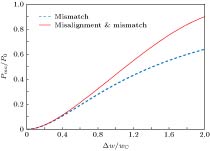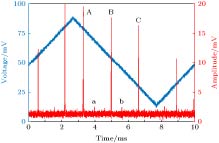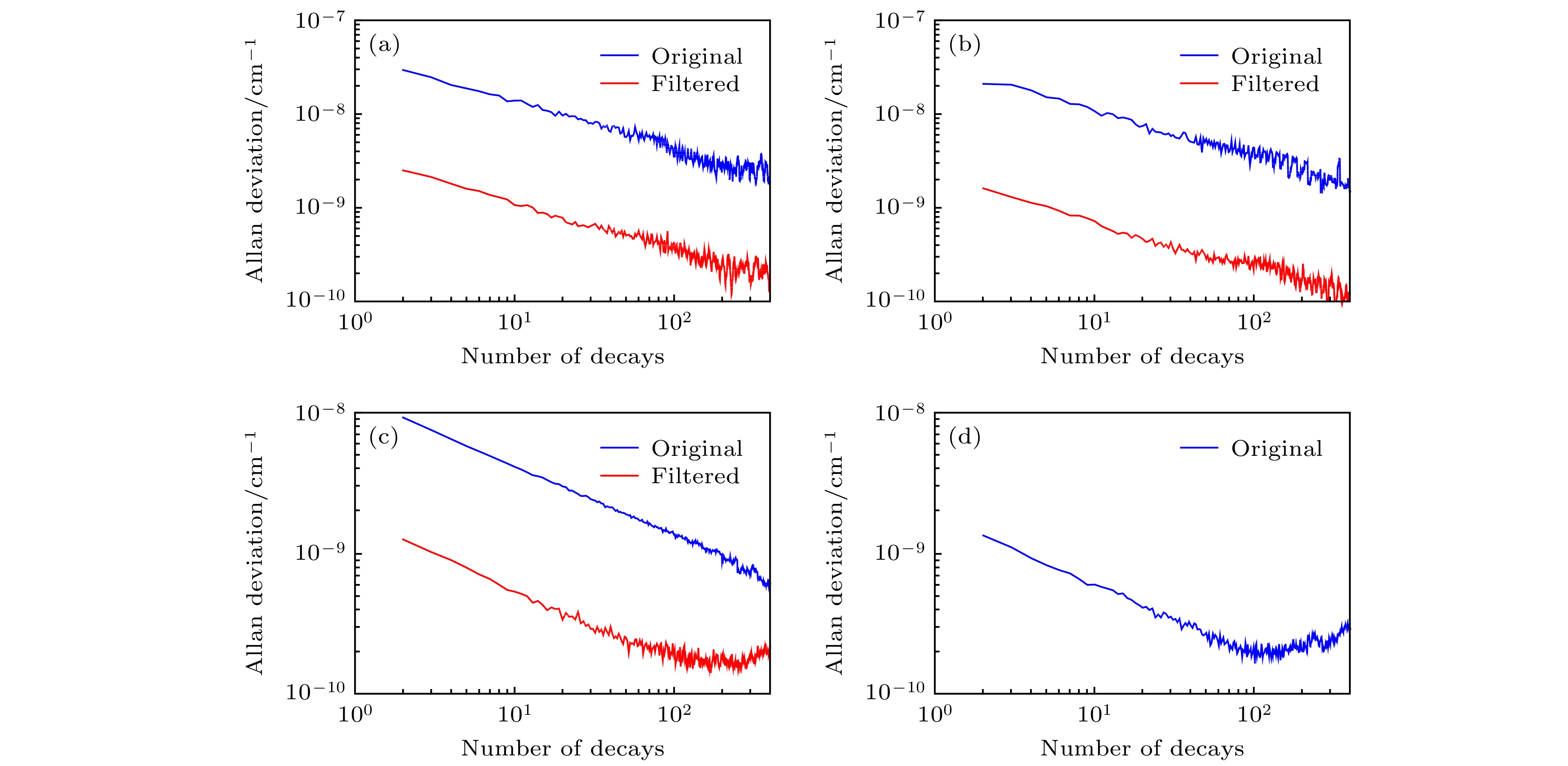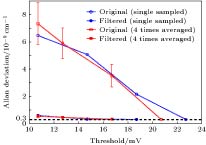-
In continuous-wave cavity ring-down spectroscopy (CW-CRDS), the measurement sensitivity is seriously affected by the multimode excitations in the ring-down cavity. The using of an intracavity aperture is a common way to restrain the excitation of high-order modes, thus leading the laser power to additionally lose and the signal-to-noise ratio to degrade. In this paper, two numerical methods, named “trigger threshold method” and “curve fitness method”, are proposed for selecting the mode in which the decays excited by the high-order modes can be removed. The laser coupling efficiency between the incident laser and the oscillating fundamental or high-order modes is studied in a misadjusted ring-down cavity. It is found that with a misadjusted ring-down cavity, the laser energy is partially coupled into the high-order modes, and the coupling energy increases with the extent of the cavity misadjustment increasing. In this case, the ring-down decaying traces excited by these high-order modes are different from and much shorter than those excited by the fundamental mode, which are respectively called “bad decays” and “good decays” in this paper. Both the fundamental mode and the high-order modes can reach the threshold in the case of low triggering threshold selection and result in the components of both good and bad decays in the output ring-down curves. When the trigger threshold rises, the bad decays are effectively restrained by the deficient coupling into the high-order modes. Thus raising the trigger threshold is an effective method to restrain bad decays for the mode selection. Another approach is to consider the time spent on turning off the laser injection since the fitting goodness of good decays is better than that of bad decays. In this paper this characteristic is also used to separate the good decays from the bad ones. These two methods are demonstrated in the CW-CRDS experiments. The results show that the sensitivity of the CW-CRDS instrument can be greatly improved by one order of magnitude in the trigger threshold method with the minimum of Allan deviations gradually approaching to a constant, while the acquisition rate of the ring-down decays slows down with the increase of the trigger threshold. The results also explain the relationship between single sampling and averaged sampling, which presents an answer to the question about the sequence choice between averaging and fitting. A numerical model is proposed to estimate the probability of good decays versus the trigger threshold, which can be used to choose appropriate trigger threshold for CW-CRDS experiment. The applicable conditions and the limitations of these two methods in CW-CRDS for trace gas detection are also discussed in the paper.
-
Keywords:
- cavity ring-down spectroscopy /
- cavity misadjustment /
- multimode decay /
- measurement sensitivity
[1] McCarren D, Scime E 2015 Rev. Sci. Instrum. 86 103505
 Google Scholar
Google Scholar
[2] 胡纯栋, 焉镜洋, 王艳, 梁立振 2018 光谱学与光谱分析 38 346
Hu C D, Yan J Y, Wang Y, Liang L Z 2018 Spectrosc. Spect. Anal. 38 346
[3] Liu Y S, Zhou L X, Tans P P, Zang K P, Cheng S Y 2018 Sci. Total Environ. 633 1022
 Google Scholar
Google Scholar
[4] Miles N L, Martins D K, Richardson S J, Rella C W, Arata C, Lauvaux T, Davis K J, Barkley Z R, McKain K, Sweeney C 2018 Atmos. Meas. Tech. 11 1273
[5] Li Z Y, Hu R Z, Xie P H, Chen H, Wu S Y, Wang F Y, Wang Y H, Ling L Y, Liu J G, Liu W Q 2018 Opt. Express 26 A433
 Google Scholar
Google Scholar
[6] Tan Y, Wang J, Zhao X Q, Liu A W, Hu S M 2017 J. Quant. Spectosc. Radiat. Transf. 187 274
 Google Scholar
Google Scholar
[7] Chen J, Hua T P, Tao L G, Sun Y R, Liu A W, Hu S M 2018 J. Quant. Spectosc. Radiat. Transf. 205 91
 Google Scholar
Google Scholar
[8] Cui H, Li B C, Han Y L, Wang J, Gao C M, Wang Y F 2017 Chin. Opt. Lett. 15 053101
 Google Scholar
Google Scholar
[9] Cui H, Li B C, Xiao S L, Han Y L, Wang J, Gao C M, Wang Y F 2017 Opt. Express 25 5807
 Google Scholar
Google Scholar
[10] Wahl E H, Tan S M, Koulikov S, Kharlamov B, Rella C R, Crosson E R, Paldus B A 2006 Opt. Express 14 1673
 Google Scholar
Google Scholar
[11] Karpf A, Qiao Y, Rao G N 2016 Appl. Opt. 55 4497
 Google Scholar
Google Scholar
[12] Berden G, Peeters R, Meijer G 2000 Int. Rev. Phys. Chem. 19 565
 Google Scholar
Google Scholar
[13] O’Keefe A, Deacon D A G 1988 Rev. Sci. Instrum. 59 2544
 Google Scholar
Google Scholar
[14] Romanini D, Kachanov A A, Stoeckel F 1997 Chem. Phys. Lett. 270 538
 Google Scholar
Google Scholar
[15] Romanini D, Kachanov A A, Sadeghi N, Stoeckel F 1997 Chem. Phys. Lett. 264 316
 Google Scholar
Google Scholar
[16] Huang H F, Lehmann K K 2007 Opt. Express 15 8745
[17] 崔立红, 赵维宁, 颜昌翔 2015 64 224211
Cui L H, Zhao W N, Yan C X 2015 Acta Phys. Sin. 64 224211
[18] Lehmann K K, Huang H F 2009 Frontiers of Molecular Spectroscopy (Amsterdam: Elsevier Science) p638
[19] Grand Y L, Taché J P, Floch A L 1990 J. Opt. Soc. Am. B 7 1251
[20] Sayeh M R, Bilger H R, Habib T 1985 Appl. Opt. 24 3756
 Google Scholar
Google Scholar
[21] Wójtewicz S, Cygan A, Domyslawska J, Bielska K, Morzyński P, Maslowski P, Ciurylo R, Lisak D 2018 Opt. Express 26 5644
 Google Scholar
Google Scholar
[22] 谭中奇, 汪之国, 龙兴武 2007 光子学报 36 60
Tan Z Q, Wang Z G, Long X W 2007 Acta Photon. Sin. 36 60
[23] Wang J D, Yu J, Mo Z Q, He J G, Dai S J, Meng J J, Liu Y, Zhang X, Yi H 2019 Appl. Opt. 58 2773
 Google Scholar
Google Scholar
-
-
[1] McCarren D, Scime E 2015 Rev. Sci. Instrum. 86 103505
 Google Scholar
Google Scholar
[2] 胡纯栋, 焉镜洋, 王艳, 梁立振 2018 光谱学与光谱分析 38 346
Hu C D, Yan J Y, Wang Y, Liang L Z 2018 Spectrosc. Spect. Anal. 38 346
[3] Liu Y S, Zhou L X, Tans P P, Zang K P, Cheng S Y 2018 Sci. Total Environ. 633 1022
 Google Scholar
Google Scholar
[4] Miles N L, Martins D K, Richardson S J, Rella C W, Arata C, Lauvaux T, Davis K J, Barkley Z R, McKain K, Sweeney C 2018 Atmos. Meas. Tech. 11 1273
[5] Li Z Y, Hu R Z, Xie P H, Chen H, Wu S Y, Wang F Y, Wang Y H, Ling L Y, Liu J G, Liu W Q 2018 Opt. Express 26 A433
 Google Scholar
Google Scholar
[6] Tan Y, Wang J, Zhao X Q, Liu A W, Hu S M 2017 J. Quant. Spectosc. Radiat. Transf. 187 274
 Google Scholar
Google Scholar
[7] Chen J, Hua T P, Tao L G, Sun Y R, Liu A W, Hu S M 2018 J. Quant. Spectosc. Radiat. Transf. 205 91
 Google Scholar
Google Scholar
[8] Cui H, Li B C, Han Y L, Wang J, Gao C M, Wang Y F 2017 Chin. Opt. Lett. 15 053101
 Google Scholar
Google Scholar
[9] Cui H, Li B C, Xiao S L, Han Y L, Wang J, Gao C M, Wang Y F 2017 Opt. Express 25 5807
 Google Scholar
Google Scholar
[10] Wahl E H, Tan S M, Koulikov S, Kharlamov B, Rella C R, Crosson E R, Paldus B A 2006 Opt. Express 14 1673
 Google Scholar
Google Scholar
[11] Karpf A, Qiao Y, Rao G N 2016 Appl. Opt. 55 4497
 Google Scholar
Google Scholar
[12] Berden G, Peeters R, Meijer G 2000 Int. Rev. Phys. Chem. 19 565
 Google Scholar
Google Scholar
[13] O’Keefe A, Deacon D A G 1988 Rev. Sci. Instrum. 59 2544
 Google Scholar
Google Scholar
[14] Romanini D, Kachanov A A, Stoeckel F 1997 Chem. Phys. Lett. 270 538
 Google Scholar
Google Scholar
[15] Romanini D, Kachanov A A, Sadeghi N, Stoeckel F 1997 Chem. Phys. Lett. 264 316
 Google Scholar
Google Scholar
[16] Huang H F, Lehmann K K 2007 Opt. Express 15 8745
[17] 崔立红, 赵维宁, 颜昌翔 2015 64 224211
Cui L H, Zhao W N, Yan C X 2015 Acta Phys. Sin. 64 224211
[18] Lehmann K K, Huang H F 2009 Frontiers of Molecular Spectroscopy (Amsterdam: Elsevier Science) p638
[19] Grand Y L, Taché J P, Floch A L 1990 J. Opt. Soc. Am. B 7 1251
[20] Sayeh M R, Bilger H R, Habib T 1985 Appl. Opt. 24 3756
 Google Scholar
Google Scholar
[21] Wójtewicz S, Cygan A, Domyslawska J, Bielska K, Morzyński P, Maslowski P, Ciurylo R, Lisak D 2018 Opt. Express 26 5644
 Google Scholar
Google Scholar
[22] 谭中奇, 汪之国, 龙兴武 2007 光子学报 36 60
Tan Z Q, Wang Z G, Long X W 2007 Acta Photon. Sin. 36 60
[23] Wang J D, Yu J, Mo Z Q, He J G, Dai S J, Meng J J, Liu Y, Zhang X, Yi H 2019 Appl. Opt. 58 2773
 Google Scholar
Google Scholar
Catalog
Metrics
- Abstract views: 8769
- PDF Downloads: 118
- Cited By: 0















 DownLoad:
DownLoad:










